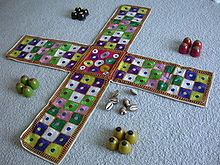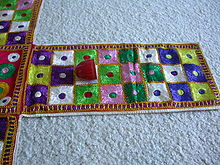- Chopat
-
Chopat (or Chaupat) is a Cross and Circle game played in Saurashtra, part of Gujarat, India.
Contents
History
It is a relatively easy game to learn but it does require skill to play this game of strategy well. Chopat is claimed to be a variation of the game of dice played in the epic poem Mahabharata between Yudhisthira and Duryodhan.
Variations are played in other parts of India1 and even Pakistan2. It is similar in some ways to Pachisi, Parcheesi and Ludo.
Its also called The Ludo grandfathers.Set up
A chopat “board” is traditionally an embroidered cloth in the shape of a cross. Each arm of the cross is divided into three columns and each column is divided into eight squares.
The “dice” are seven cowry shells.
The “men” or pieces are usually made of wood. Each player has four men.Rules
A maximum of four players play this game, each sitting in front of an arm of the cross.
The centre of the cross is “ghar" or "home” for all players.
The center column on each arm of the cross is the "home column" for each player’s men after they cross the flower motif.
The starting point for each player is the flower motif on the column to the left of his home column.
Each player is required to enter his four men into the game from the starting point. The men travel around the outer perimeter columns (17 squares per arm of the cross) in a clockwise direction.
Before a player can bring any of his own men “home”, he has to knock out at least one man of another player. This is called a “tohd”.
Only the player’s own men can enter the home column of each player. Once the men cross the flower motif, they are played by laying the pieces on their side to indicate they are in their final home stretch and are safe now from any further attack.Cowry Shells
All seven cowry shells are used in each throw.
Scoring is as follows:
All 7 facing down – 8 points
1 facing up, 6 facing down – 11 points
2 facing up, 5 facing down – 2 points
3 facing up, 4 facing down – 3 points
4 facing up, 3 facing down – 4 points
5 facing up, 2 facing down – 25 points
6 facing up, 1 facing down – 30 points
All 7 facing up – 16 pointsEntering men
To start, each player takes turns throwing the cowry shells. The player with the highest score starts first.
A player can only enter a man into the game if he has a “high” throw - 8 points or higher.
The starting point for each player is the flower motif on the column to the left of his home column.Playing
The men travel around the outer perimeter columns in a clockwise direction from their starting flower motifs.
For each high throw, a player gets an additional throw. If he has three consecutive high throws, they “burn” up - "beli jaye" and he loses a turn.
If a player has multiple throws in a turn because of a “high” throw, he is allowed to move different men for each of the throws.
Once all four of his men have entered into play, any further throws of 11, 25 or 30 points by the player results in the granting of one additional step or point called “peghedu”. This is a bonus point. This peghedu (single step) may be used to move another man, separate from the man moved for the throw itself.
At any point in the game, if a player has no men who can move the amount of a throw, that throw is forfeited.Safe Squares
The squares with the flower motifs are “safe” squares. Two opposing players’ men can both land on the same square with no harm to either.
If two men of the same player rest on a single square, they are safe. Men of other players can move past this square on their turn although they cannot land there.Knock Out
Each player has to knock out at least one man of another player – do a “tohd” or "hit" - before he can bring any of his men home.
This is done by landing his man on any square other than one with a flower motif, occupied by a single man of his opponent. The knocked out man is taken out of play and has to be re-entered into the game the usual way.Counting Strategies
Each arm of the cross has 17 squares for moving so:
1. "aanth ghar pacchees" - move 8 for throw of 25 - count 8 squares forward and move to the corresponding square on the next arm of the cross.
2. "tehr ghar trees" - move 13 for throw of 30 - count 13 squares forward and move to the corresponding square on the next arm of the cross.Coming Home
The home column for each player can only be entered by his men if he has already made at least one “tohd”.
Once the men cross the flower motif, they are played by laying the pieces on their side to indicate they are in their final home stretch and are safe now from any further attack.
Each man enters the center cross “home” only with the exact number of steps. If the throw is higher than the required number of steps, and if it cannot be used by any other of his men still in play, that throw is forfeited.Winning
The first player who brings all four of his men home is the winner.
Play continues for second and third places until one last player has men remaining on the board.Continue playing
After a player has brought all his men home, he can continue to play with the others.
This is called “gandu kadhyu” - being silly. The player can move one of his men out of the cross center home and enter play in a counter-clockwise direction with the piece played lying on its side. This man can knock out other men but cannot itself be knocked out. This is a source of much hilarity!See also
Other cross and circle games
References
1. The Hindu of India <http://www.hindu.com/2007/10/07/stories/2007100757860400.htm>
2. Daily Times of Pakistan <http://www.dailytimes.com.pk/default.asp?page=story_21-6-2005_pg7_18>Categories:- Cross and Circle games
- Traditional board games
- Indian games
Wikimedia Foundation. 2010.




